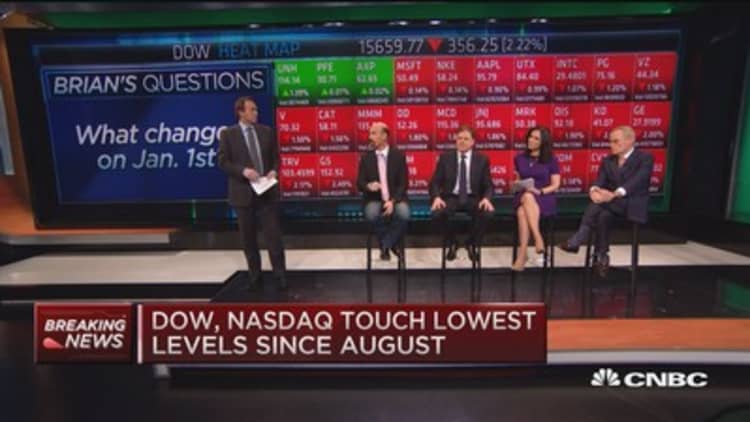
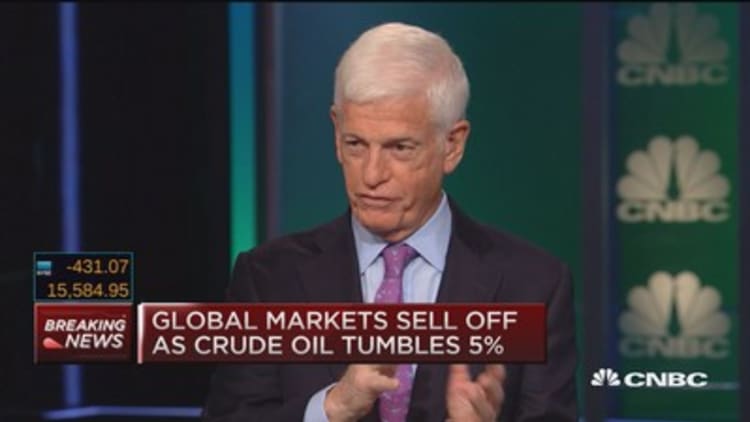

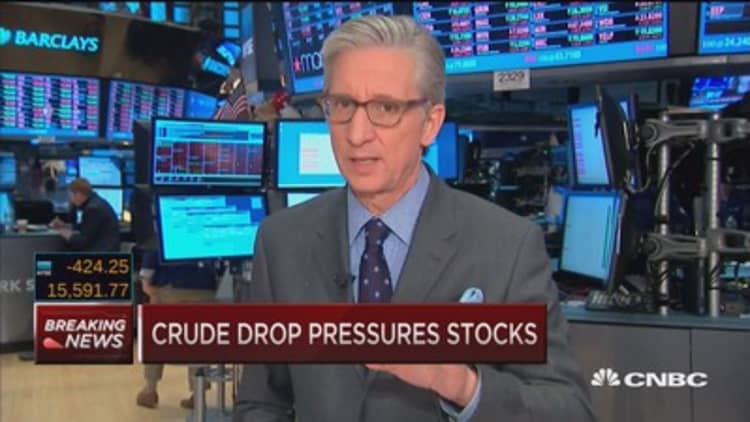
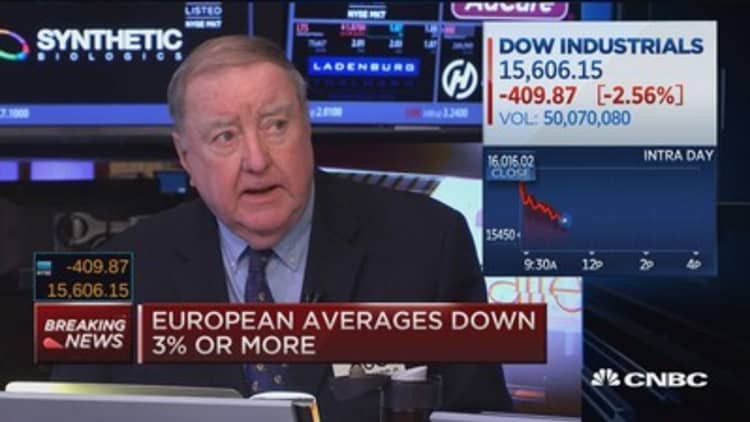

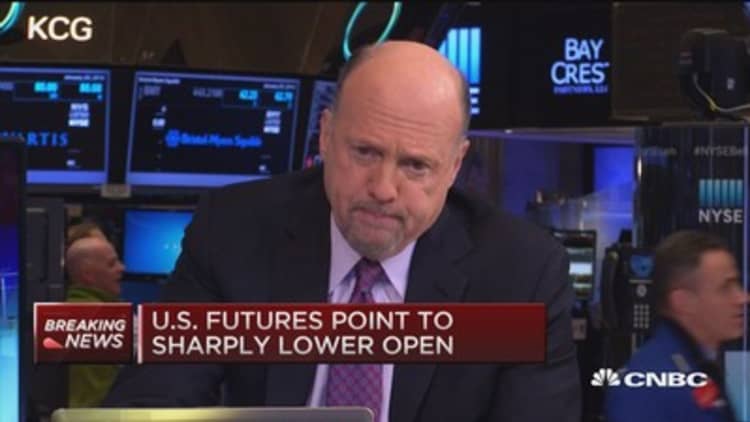

U.S. stocks closed lower Wednesday but well above session lows as the S&P 500 held a technical level and biotechs recovered in late trade. (Tweet This)
Traders noted that once the S&P 500 tested the 1,800 level in early afternoon trade, buyers started to come in.
"Any rally that starts is going to be violent to the upside," said Art Hogan, chief market strategist at Wunderlich Securities.
Read More Why the wild market reversal
Small-cap stocks and biotechs led the initial recovery. The major averages more than halved intraday losses, with the Nasdaq composite attempting gains as the close approached, but the late-day rally lost steam. The S&P 500 ended at its lowest level since April 2014.
"People who caught a free ride on the way up are getting out of it," said Jeremy Klein, chief market strategist at FBN Securities.
The major U.S. averages are down more than 9 percent for the year so far and are more than 10 percent below their 52-week intraday highs, in correction territory.
The Dow Jones industrial average closed about 250 points lower after earlier falling nearly 566 points with IBM contributing the most to declines. UnitedHealth contributed the most to gains.
The S&P 500 closed 1.17 percent lower, near 1,859, after earlier falling more than 3.5 percent through its October 2014 intraday low of 1,820 to hit its lowest since February 2014. Energy closed down nearly 3 percent after briefly dipping 6 percent.
The Russell 2000 closed about half a percent higher after falling 3.66 percent intraday. The Dow transports briefly turned higher before closing down about half a percent, still well off an earlier decline of more than 3.5 percent.
"The market's been hurt in the past two-and-a-half weeks by strong openings. That invites selling," said Bruce Bittles, chief investment strategist at RW Baird. "Today the market opened sharply down and that shows a lot of pessimism here and may help turn things around."
The Nasdaq composite closed mildly lower at its lowest since October 2014 after attempting to recover from an intraday decline of more than 3.5 percent. The iShares Nasdaq Biotechnology ETF (IBB) reversed a decline of more than 3 percent to end up 2.75 percent, but well off session highs of 4 percent gains.
"My guess is what you're seeing right now is some short covering," said Paul Yook, portfolio manager at BioShares Funds, adding "the outlook for the sector is actually really good."
Netflix ended mildly lower, while Apple closed a touch higher, both reversing sharp declines in intraday trade.
"Obviously you're going to have to bounce at some point. The biggest thing I've seen is the reversal in the biotech stocks," said Peter Coleman, head trader at Convergex.
"Once you start to get a lift off the lows you're always going to get short covering," he said, noting he remains a "little skeptical" the intraday recovery can hold.
About 11 stocks declined for every four advancers on the New York Stock Exchange, with an exchange volume of nearly 1.5 billion and a composite volume of nearly 6.4 billion in afternoon trade. Earlier, about 30 stocks declined for every advancer.
The number of new 52-week lows on the New York Stock Exchange (1,357) and Nasdaq (853) were the most on a single day since November 2008.
The recovery is "just real tenuous," said JJ Kinahan, chief strategist at TD Ameritrade. "The bonds have also stayed in check. … The signals that show concern are starting to turn around."
The VIX came off session highs of 32 to hold near 27.
"Even if we have a bit of a bounce we're going to have very tentative buyers," Kinahan said. "We have a very high correlation to crude, so what crude does is what the market is taking its clues from. Because we traded near 1,800 today, we may go back and test that again. People are not anxious to step in front of a train."
Oil continued its decline as concerns of oversupply persisted. U.S. crude oil futures for February settled down $1.91, or 6.71 percent, at $26.55 a barrel, its lowest since May 2003.
The February contract expired at the Wednesday settle, which traders said likely contributed to some volatility in oil markets. The March contract also declined, settling down 4.1 percent at $28.35 a barrel.
"Oil is certainly weighing on investors' psyche," said Eric Wiegand, senior portfolio manager at U.S. Bank Private Client Reserve. "It's the absence of growth. The economic data we've seen out of the U.S. has been mixed. It really comes to where is growth likely to take hold."
"Our premise is markets will follow the direction of earnings to the extent that we see some earnings growth and that may come from reduced volatility in currencies," he said.
Read MoreMSCI global stock market index hits bear market
"Obviously we're in the throes of an environment where sentiment is not positive about risk assets, so it takes very little to put pressure ... Pressure coming from falling oil prices continues to serve as a cues for equities to follow suit," said Mark Luschini, chief investment strategist at Janney Montgomery Scott.
ended about 3 percent lower or more. closed deep in the red, with the Nikkei 225 down 3.7 percent to end more than 20 percent below its 52-week intraday high, in bear market territory.
Traders have been watching the S&P 500's August low of 1,867. The index broke below that level in intraday trade Tuesday and Friday, and closed below Wednesday. U.S. stock markets were closed Monday for a holiday.
"The S&P futures are decisively below their August low this morning in a bearish development," BTIG Chief Technical Strategist Katie Stockton said in a Wednesday morning note. "The inability of the market to sustain yesterday morning's strength is a message — downside momentum is strong enough to maintain oversold conditions."
"This is characteristic of a downtrend, as opposed to a correction," she said. "There are times at which the contrarian extremes in our market internal measures are no longer bullish, even from a short-term perspective, and there currently appears to be risk of that."
Read MoreOne strategy that has had some success in 2016
In economic news, the December U.S. CPI showed a 0.1 percent decline. Ex-food and energy, the index rose 0.1 percent after rising 0.2 percent for three straight months, according to Reuters. In the 12 months through December, this so-called core CPI rose 2.1 percent, the largest gain since July 2012, after climbing 2.0 percent in November.
Building permits fell 3.9 percent in December. Housing starts fell 2.5 percent but the seasonally adjusted annual pace remained above a 1 million.
Dow futures traded about 250 points lower after the data and a slight recovery in oil. Earlier, Dow futures were off more than 300 points.
Read More'Selling stampede' not over
"Today's data on CPI and housing starts ... were soft in both cases, continuing to support a case that the Fed will continue to lower its dot plot," Luschini said.
Treasury yields held lower, with the 2-year yield near 0.83 percent and the 10-year yield at 1.99 percent.
The U.S. dollar index held mildly higher against major world currencies, with the euro just below $1.09 and the yen at 116.96 yen against the greenback.
"CPI fell even though the core rate remained (relatively) unchanged," said Peter Cardillo, chief market economist at First Standard Financial. "I think if this continues the Fed may have to change course."
Read MoreTraders pricing in only one Fed rate hike in 2016
"There's no question the markets are oversold. You look at the earnings, they're basically coming in on target," he said. "What the market is missing here is a real climactic sell-off that could bring us to capitulation. I'm not sure it happens today, but we're getting closer to it."
In corporate news, Goldman Sachs reported earnings that beat expectations on both lines. However, profit fell for a third-straight quarter, hit by a $5 billion settlement of crisis-era legal claims. The stock closed down nearly 2 percent.
F5 Networks and SLM are both set to report after the bell.
"Earnings much more in the forefront of investor attention this week. We've had the large financials generally meeting or exceeding expectations, but not able to resurrect the sentiment in the market," Wiegand said.
Major U.S. Indexes
Read MoreEarly movers: GS, AMTD, GE, TEL, NFLX, IBM, AAPL, MET & more
The Dow Jones industrial average closed down 249.28 points, or 1.56 percent, to 15,766.74, with IBM leading decliners and UnitedHealth the greatest advancer.
The closed down 22.00 points, or 1.17 percent, to 1,859.33, with energy leading nine sectors lower and health care the only gainer.
The Nasdaq composite declined 5.26 points, or 0.12 percent, to 4,471.69.
The CBOE Volatility Index (VIX), widely considered the best gauge of fear in the market, traded below 27. Intraday, the VIX hit a high of 32, its highest since Sept. 1.
Gold futures for February delivery settled up $17.10 at $1,106.20 an ounce.
On tap this week:
Thursday
Earnings: American Express, Travelers, Fifth Third, ETrade, Starbucks, Intuitive Surgical, Union Pacific, Verizon, Bank of NY Mellon, Alaska Air, Southwest Air, JB Hunt, KeyCorp, Canadian Pacific Railway, Schlumberger, People's United Financial
8:30 a.m.: Jobless claims
8:30 a.m.: Philadelphia Fed business outlook survey
10:30 a.m.: Natural gas inventories
11:00 a.m.: Oil inventories
4:30 p.m.: Fed balance sheet, monetary supply
Friday
Earnings: General Electric, Kansas City Southern, SunTrust, Legg Mason, Synchrony Financial, SAP
8:30 a.m.: Chicago Fed national activity index
9:45 a.m.: Manufacturing PMI
10 a.m.: Existing home sales
10 a.m.: Leading indicators
1 p.m.: Oil rig count
*Planner subject to change.
More From CNBC.com:





